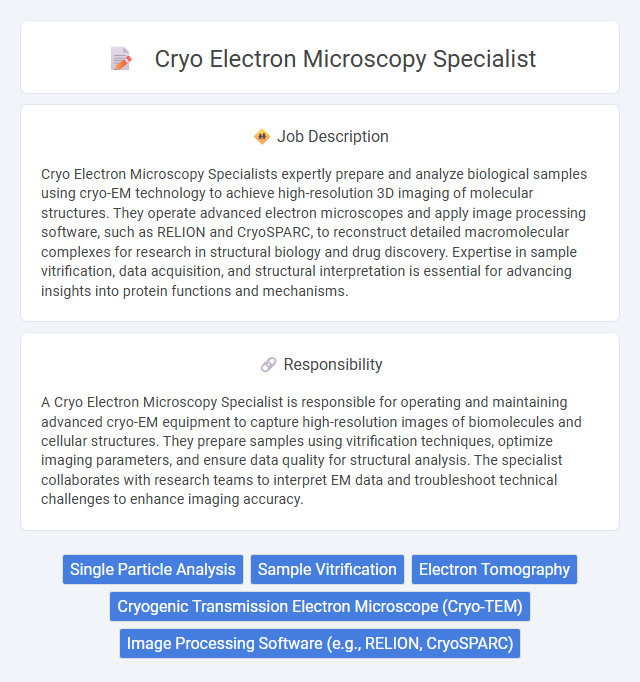
Cryo Electron Microscopy Specialists expertly prepare and analyze biological samples using cryo-EM technology to achieve high-resolution 3D imaging of molecular structures. They operate advanced electron microscopes and apply image processing software, such as RELION and CryoSPARC, to reconstruct detailed macromolecular complexes for research in structural biology and drug discovery. Expertise in sample vitrification, data acquisition, and structural interpretation is essential for advancing insights into protein functions and mechanisms.
Individuals with strong analytical skills and a detail-oriented mindset are likely to thrive as Cryo Electron Microscopy Specialists due to the precision required in imaging biological samples. Those who can tolerate working in controlled, low-temperature environments and handle complex instrumentation might find the role well-suited to their abilities. People who prefer repetitive tasks without the demand for technical troubleshooting could have a lower probability of success in this specialized field.
Qualification
A Cryo Electron Microscopy Specialist must possess extensive knowledge of cryo-EM techniques, including sample preparation, data acquisition, and 3D image reconstruction. Expertise in operating advanced electron microscopes, such as Titan Krios or Talos Arctica, and proficiency with software like RELION and CryoSPARC are essential. A strong background in structural biology, biophysics, or related fields, often supported by a Master's or PhD degree, enhances the ability to analyze macromolecular complexes at near-atomic resolution.
Responsibility
A Cryo Electron Microscopy Specialist is responsible for operating and maintaining advanced cryo-EM equipment to capture high-resolution images of biomolecules and cellular structures. They prepare samples using vitrification techniques, optimize imaging parameters, and ensure data quality for structural analysis. The specialist collaborates with research teams to interpret EM data and troubleshoot technical challenges to enhance imaging accuracy.
Benefit
Cryo Electron Microscopy Specialists are likely to benefit from working at the forefront of structural biology, gaining access to cutting-edge technology that enhances detailed molecular visualization. The role may offer substantial opportunities for collaborative research and professional growth within prestigious academic or pharmaceutical institutions. Exposure to emerging techniques and high-impact projects could significantly boost career prospects and scientific contributions.
Challenge
Cryo Electron Microscopy Specialists likely face the challenge of maintaining optimal sample integrity while achieving high-resolution imaging under cryogenic conditions. The complexity of aligning electron optics and minimizing beam-induced damage probably requires advanced technical skills and meticulous attention to detail. Managing data processing workflows and interpreting three-dimensional reconstructions also presents ongoing challenges that demand both expertise and innovative problem-solving.
Career Advancement
Cryo Electron Microscopy Specialists can advance their careers by gaining expertise in high-resolution imaging techniques and contributing to groundbreaking structural biology research projects. Mastery of data analysis software such as RELION and CryoSPARC enhances opportunities for leadership roles in academic or pharmaceutical research institutions. Networking with interdisciplinary teams and publishing in high-impact journals further accelerates professional growth and recognition in the field.
Key Terms
Single Particle Analysis
A Cryo Electron Microscopy Specialist skilled in Single Particle Analysis excels in capturing high-resolution 3D structures of macromolecules by processing thousands of individual particle images. Expertise in software like RELION, CryoSPARC, and EMAN2 is essential for accurate image alignment, classification, and 3D reconstruction. This role demands proficiency in electron microscopy instrumentation, sample preparation, and data interpretation to facilitate structural biology research and drug discovery projects.
Sample Vitrification
Cryo Electron Microscopy Specialists expertly prepare biological samples through vitrification, rapidly freezing them to preserve native structures without ice crystal formation. This process ensures high-resolution imaging by maintaining specimens in a near-native state essential for accurate 3D reconstruction. Proficiency in optimizing freezing parameters and handling delicate samples is critical for producing consistently high-quality cryo-EM data.
Electron Tomography
Electron Tomography experts in Cryo Electron Microscopy specialize in producing high-resolution 3D reconstructions of biological specimens by acquiring tilt-series images under cryogenic conditions. Proficiency in advanced image processing software, such as IMOD or Dynamo, is essential to accurately align and reconstruct volumetric data. Their work enables detailed visualization of macromolecular complexes in near-native states, critical for structural biology and drug discovery.
Cryogenic Transmission Electron Microscope (Cryo-TEM)
Cryo Electron Microscopy Specialists expertly operate Cryogenic Transmission Electron Microscopes (Cryo-TEM) to visualize biomolecules at near-atomic resolution in their native hydrated state, enabling critical insights into molecular structures. They optimize sample vitrification techniques and maintain ultra-low temperature conditions to preserve specimen integrity during imaging. Proficiency in image processing software and 3D reconstruction methods is essential for analyzing Cryo-TEM data and advancing structural biology research.
Image Processing Software (e.g., RELION, CryoSPARC)
Cryo Electron Microscopy Specialists expertly utilize image processing software such as RELION and CryoSPARC to reconstruct high-resolution 3D structures from 2D cryo-EM images. Proficiency in motion correction, particle picking, and 3D classification within these platforms is essential for enhancing data quality and structural accuracy. Advanced knowledge of these tools accelerates the interpretation of complex macromolecular assemblies and supports cutting-edge structural biology research.
 kuljobs.com
kuljobs.com